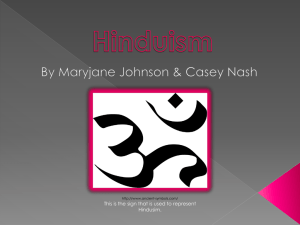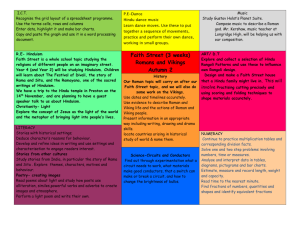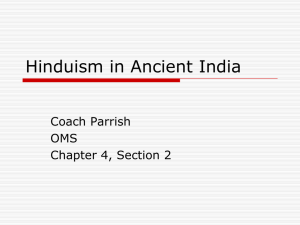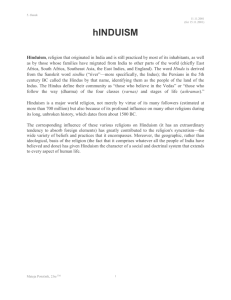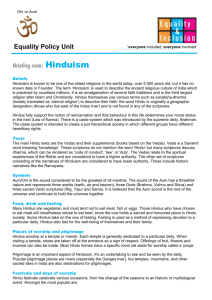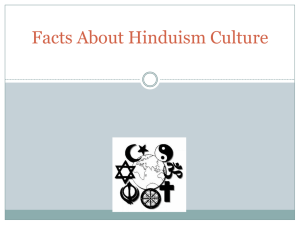HINDUISM
advertisement
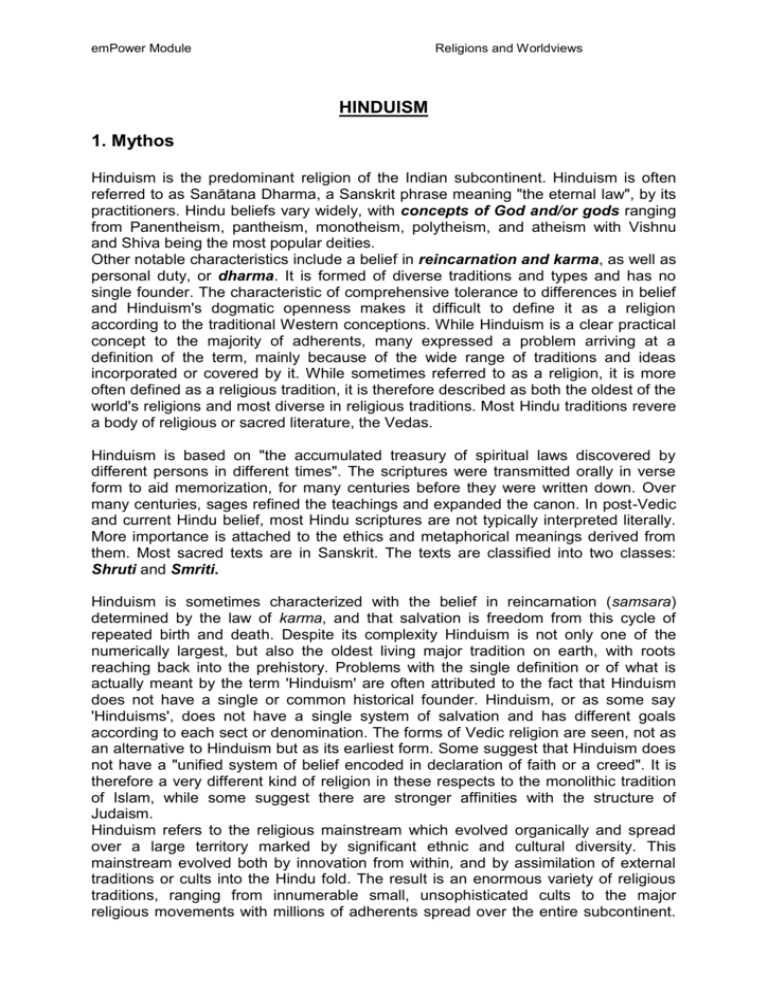
emPower Module Religions and Worldviews HINDUISM 1. Mythos Hinduism is the predominant religion of the Indian subcontinent. Hinduism is often referred to as Sanātana Dharma, a Sanskrit phrase meaning "the eternal law", by its practitioners. Hindu beliefs vary widely, with concepts of God and/or gods ranging from Panentheism, pantheism, monotheism, polytheism, and atheism with Vishnu and Shiva being the most popular deities. Other notable characteristics include a belief in reincarnation and karma, as well as personal duty, or dharma. It is formed of diverse traditions and types and has no single founder. The characteristic of comprehensive tolerance to differences in belief and Hinduism's dogmatic openness makes it difficult to define it as a religion according to the traditional Western conceptions. While Hinduism is a clear practical concept to the majority of adherents, many expressed a problem arriving at a definition of the term, mainly because of the wide range of traditions and ideas incorporated or covered by it. While sometimes referred to as a religion, it is more often defined as a religious tradition, it is therefore described as both the oldest of the world's religions and most diverse in religious traditions. Most Hindu traditions revere a body of religious or sacred literature, the Vedas. Hinduism is based on "the accumulated treasury of spiritual laws discovered by different persons in different times". The scriptures were transmitted orally in verse form to aid memorization, for many centuries before they were written down. Over many centuries, sages refined the teachings and expanded the canon. In post-Vedic and current Hindu belief, most Hindu scriptures are not typically interpreted literally. More importance is attached to the ethics and metaphorical meanings derived from them. Most sacred texts are in Sanskrit. The texts are classified into two classes: Shruti and Smriti. Hinduism is sometimes characterized with the belief in reincarnation (samsara) determined by the law of karma, and that salvation is freedom from this cycle of repeated birth and death. Despite its complexity Hinduism is not only one of the numerically largest, but also the oldest living major tradition on earth, with roots reaching back into the prehistory. Problems with the single definition or of what is actually meant by the term 'Hinduism' are often attributed to the fact that Hinduism does not have a single or common historical founder. Hinduism, or as some say 'Hinduisms', does not have a single system of salvation and has different goals according to each sect or denomination. The forms of Vedic religion are seen, not as an alternative to Hinduism but as its earliest form. Some suggest that Hinduism does not have a "unified system of belief encoded in declaration of faith or a creed". It is therefore a very different kind of religion in these respects to the monolithic tradition of Islam, while some suggest there are stronger affinities with the structure of Judaism. Hinduism refers to the religious mainstream which evolved organically and spread over a large territory marked by significant ethnic and cultural diversity. This mainstream evolved both by innovation from within, and by assimilation of external traditions or cults into the Hindu fold. The result is an enormous variety of religious traditions, ranging from innumerable small, unsophisticated cults to the major religious movements with millions of adherents spread over the entire subcontinent. emPower Module Religions and Worldviews The identification of Hinduism as an independent religion separate from Buddhism or Jainism consequently hinges on the affirmation of its adherents that it is such. Most Hindus believe that the spirit or soul, the ātman, is eternal. According to the monistic/pantheistic theologies of Hinduism, this Atman is ultimately indistinct from Brahman, the supreme spirit. Hence, these schools are called non-dualist. The goal of life, according to the Advaita school, is to realize that one's ātman is identical to Brahman, the supreme soul.] The Upanishads state that whoever becomes fully aware of the ātman as the innermost core of one's own self realizes an identity with Brahman and thereby reaches moksha (liberation or freedom). Dualistic schools understand Brahman as a Supreme Being who possesses personality, and they worship him or her thus, as Vishnu, Brahma, Shiva, or Shakti, depending on the sect. The ātman is dependent on God, while moksha depends on love towards God and on God's grace. When God is viewed as the supreme personal being (rather than as the infinite principle), God is called Ishvara ("The Lord"), Bhagavan ("The Auspicious One") or Parameshwara ("The Supreme Lord"). The Hindu scriptures refer to celestial entities called Devas (or devī in feminine form), "the shining ones", which may be translated into English as "gods" or "heavenly beings". The devas are an integral part of Hindu culture and are depicted in art, architecture and through icons, and mythological stories about them are related in the scriptures, particularly in Indian epic poetry and the Puranas. They are, however, often distinguished from Ishvara, a supreme personal god, with many Hindus worshiping Ishvara in a particular form as their iṣṭa devatā, or chosen ideal. The choice is a matter of individual preference and regional and family traditions. Hindu epics and the Puranas relate several episodes of the descent of God to Earth in corporeal form to restore dharma in society and guide humans to moksha. Such an incarnation is called an avatar. The most prominent avatars are of Vishnu and include Rama (protagonist in Ramayana) and Krishna (a central figure in the epic Mahabharata). Karma translates literally as action, work, or deed and can be described as the "moral law of cause and effect". According to the Upanishads an individual, known as the jiva-atma, develops sanskaras (impressions) from actions, whether physical or mental. The linga sharira, a body more subtle than the physical one but less subtle than the soul, retains impressions, carrying them over into the next life, establishing a unique trajectory for the individual. Thus, the concept of a universal, neutral, and never-failing karma intrinsically relates to reincarnation as well as one's personality, characteristics, and family. Karma binds together the notions of free will and destiny. This cycle of action, reaction, birth, death and rebirth is a continuum called samsara. The notion of reincarnation and karma is a strong premise in Hindu thought. Samsara provides ephemeral pleasures, which lead people to desire rebirth so as to enjoy the pleasures of a perishable body. However, escaping the world of samsara through moksha is believed to ensure lasting happiness and peace. It is thought that after several reincarnations, an atman eventually seeks unity with the cosmic spirit (Brahman/Paramatman). The ultimate goal of life, referred to as moksha, nirvana or samadhi, is understood in several different ways: as the realization of one's union with God; as the realization of one's eternal relationship with God; realization of the unity of all existence; perfect unselfishness and knowledge of the Self; as the attainment of perfect mental peace; emPower Module Religions and Worldviews and as detachment from worldly desires. Such a realization liberates one from samsara and ends the cycle of rebirth. The exact conceptualization of moksha differs among the various Hindu schools of thought. For example, Advaita Vedanta holds that after attaining moksha an atman no longer identifies itself with an individual but as identical with Brahman in all respects. The followers of Dvaita (dualistic) schools identify themselves as part of Brahman, and after attaining moksha expect to spend eternity in a loka (heaven), in the company of their chosen form of Ishvara. Thus, it is said the followers of dvaita wish to "taste sugar", while the followers of Advaita wish to "become sugar". The earliest evidence for prehistoric religion in India date back to the late Neolithic in the early Harappan period (5500–2600 BCE). The beliefs and practices of the pre-classical era (1500–500 BCE) are called the "historical Vedic religion". Modern Hinduism grew out of the Vedas, the oldest of which is the Rigveda, dated to 1700–1100 BCE. The Vedas center on worship of deities such as Indra, Varuna and Agni, and on the Soma ritual. They performed fire-sacrifices, called yajña, and chanted Vedic mantras but did not build temples or icons. The oldest Vedic traditions exhibit strong similarities to Zoroastrianism and other Indo-European religions. The major Sanskrit epics, Ramayana and Mahabharata, were compiled over a protracted period during the late centuries BCE and the early centuries CE. They contain mythological stories about the rulers and wars of ancient India, and are interspersed with religious and philosophical treatises. The later Puranas recount tales about devas and devis, their interactions with humans and their battles against demons. Three major movements underpinned the naissance of a new epoch of Hindu thought: the advent and spread of Upanishadic, Jaina, and Buddhist philosophicoreligious thought throughout the broader Indian landmass. The Upanishads, Mahavira (24th Tirthankar of Jains) and Buddha (founder of Buddhism) taught that to achieve moksha or nirvana, one did not have to accept the authority of the Vedas or the caste system. Buddha went a step further and claimed that the existence of a Self/soul or God was unnecessary. Buddhism peaked during the reign of Asoka the Great of the Mauryan Empire, who unified the Indian subcontinent in the 3rd century BCE. After 200 CE several schools of thought were formally codified in Indian philosophy, including Samkhya, Yoga, Nyaya, Vaisheshika, Purva-Mimamsa and Vedanta. Charvaka, the founder of an atheistic materialist school, came to the fore in North India in the sixth century BCE. Between 400 BCE and 1000 CE Hinduism expanded at the expense of Buddhism. Sanskritic culture goes into decline after the end of the Gupta period. The early medieval Puranas helped establish a religious mainstream among the pre-literate tribal societies undergoing acculturation. The tenets of Brahmanic Hinduism and of the Dharmashastras underwent a radical transformation at the hands of the Purana composers, resulting in the rise of a mainstream "Hinduism" that overshadowed all earlier traditions. Though Islam came to India in the early 7th century with the advent of Arab traders and the conquest of Sindh, it started to become a major religion during the later Muslim conquest in the Indian subcontinent. During this period Buddhism declined rapidly and many Hindus converted to Islam. Numerous Muslim rulers such as Aurangzeb destroyed Hindu temples and persecuted non-Muslims; however some, such as Akbar, were more tolerant. Hinduism underwent profound changes, in large part due to the influence of the prominent teachers Ramanuja, Madhva, and Chaitanya. Followers of the Bhakti movement moved away from the abstract concept emPower Module Religions and Worldviews of Brahman, which the philosopher Adi Shankara consolidated a few centuries before, with emotional, passionate devotion towards the more accessible avatars, especially Krishna and Rama. 2. Ethos In whatever way a Hindu defines the goal of life, there are several methods (yogas) that sages have taught for reaching that goal. Texts dedicated to Yoga include the Bhagavad Gita, the Yoga Sutras, the Hatha Yoga Pradipika, and, as their philosophical and historical basis, the Upanishads. Paths one can follow to achieve the spiritual goal of life (moksha, samadhi or nirvana) include: Bhakti Yoga (the path of love and devotion) Karma Yoga (the path of right action) Rāja Yoga (the path of meditation) Jñāna Yoga (the path of wisdom) An individual may prefer one or some yogas over others, according to his or her inclination and understanding. Some devotional schools teach that bhakti is the only practical path to achieve spiritual perfection for most people, based on their belief that the world is currently in the Kali Yuga (one of four epochs part of the Yuga cycle). Practice of one yoga does not exclude others. Many schools believe that the different yogas naturally blend into and aid other yogas. For example, the practice of jnana yoga, is thought to inevitably lead to pure love (the goal of bhakti yoga), and vice versa. Someone practicing deep meditation (such as in raja yoga) must embody the core principles of karma yoga, jnana yoga and bhakti yoga, whether directly or indirectly. Hindus advocate the practice of ahiṃsā (non-violence) and respect for all life because divinity is believed to permeate all beings, including plants and non-human animals. The term ahiṃsā appears in the Upanishads,] the epic Mahabharata and Ahiṃsā is the first of the five Yamas (vows of self-restraint) in Patanjali's Yoga Sutras. In accordance with ahiṃsā, many Hindus embrace vegetarianism to respect higher forms of life. While vegetarianism is not a requirement, it is recommended for a satvic (purifying) lifestyle. Estimates of the number of lacto vegetarians in India (includes inhabitants of all religions) vary between 20% and 42%. The food habits vary with the community and region, for example some castes having fewer vegetarians and coastal populations relying on seafood. Some Hindus avoid onion and garlic, which are regarded as rajasic foods. Some avoid meat on specific holy days. Observant Hindus who do eat meat almost always abstain from beef. The largely pastoral Vedic people and subsequent generations relied heavily on the cow for its milk (for protein), its dung (for fuel and fertilizer), and its labour (tilling the fields). Thus the cow was identified as a caretaker and a maternal figure, and Hindu society honors the cow as a symbol of unselfish giving. Cow-slaughter is legally banned in almost all states of India. Hindu Rajputs that eat meat, only eat meat that has been defined as Jhatka. Due to philosophical differences and dietary needs among many modern Indian Hindus, all meat is considered a taboo except mutton, goat, chicken and fish. emPower Module Religions and Worldviews 3. Societas Hindu society has traditionally been categorized into four classes, called Varnas (Sanskrit: "colour, form, appearance"); the Brahmins: teachers and priests; the Kshatriyas: warriors, nobles, and kings; the Vaishyas: farmers, merchants, and businessmen; and the Shudras: servants and labourers. Hindus and scholars debate whether the caste system is an integral part of Hinduism sanctioned by the scriptures or an outdated social custom. Although the scriptures, since the Rigveda (10.90), contain passages that clearly sanction the Varna system, they contain indications that the caste system is not an essential part of the religion. Both sides in the debate can find scriptural support for their views. The oldest scriptures, the Vedas, strongly sustain the division of society into four classes (varna) but place little emphasis on the caste system, showing that each individual should find his strengths through different ways such as his astrological signs, actions, personality, and appearance, and do his job for the good of that individual as well as society. Being casted into a class because of what parents he was born from was a political problem and not from the actual science of the religion. A verse from the Rig Veda indicates that a person's occupation was not necessarily determined by that of his family. 4. Ritus The vast majority of Hindus engage in religious rituals on a daily basis, Most Hindus observe religious rituals at home, but observation of rituals greatly vary among regions, villages, and individuals. Devout Hindus perform daily chores such as worshiping at the dawn after bathing (usually at a family shrine, and typically includes lighting a lamp and offering foodstuffs before the images of deities), recitation from religious scripts, singing devotional hymns, meditation, chanting mantras, reciting scriptures etc. A notable feature in religious ritual is the division between purity and pollution. Religious acts presuppose some degree of impurity or defilement for the practitioner, which must be overcome or neutralised before or during ritual procedures. Purification, usually with water, is thus a typical feature of most religious action. Other characteristics include a belief in the efficacy of sacrifice and concept of merit, gained through the performance of charity or good works, that will accumulate over time and reduce sufferings in the next world. Vedic rites of fireoblation (yajna) are now only occasional practices, although they are highly revered in theory. In Hindu wedding and burial ceremonies, however, the yajña and chanting of Vedic mantras are still the norm. The rituals, upacharas, change with time. For instance, in the past few hundred years some rituals, such as sacred dance and music offerings in the standard Sodasa Upacharas set prescribed by the Agama Shastra, were replaced by the offerings of rice and sweets. Occasions like birth, marriage, and death involve what are often elaborate sets of religious customs. In Hinduism, life-cycle rituals include Annaprashan (a baby's first intake of solid food), Upanayanam ("sacred thread ceremony" undergone by uppercaste children at their initiation into formal education.)and Shraadh (ritual of treating people to feasts in the name of the deceased). For most people in India, the betrothal of the young couple and the exact date and time of the wedding are matters decided emPower Module Religions and Worldviews by the parents in consultation with astrologers. On death, cremation is considered obligatory for all except sanyasis, hijra and children under five.[ Cremation is typically performed by wrapping the corpse in cloth and burning it on a pyre. Pilgrimage is not mandatory in Hinduism, though many adherents undertake them. The Kumbh Mela (the "pitcher festival") is one of the holiest of Hindu pilgrimages that is held every four years; the location is rotated among Allahabad, Haridwar, Nashik, and Ujjain. Another important set of pilgrimages are the Shakti Peethas, where the Mother Goddess is worshipped, the two principal ones being Kalighat and Kamakhya. Hinduism has many festivals throughout the year. The Hindu calendar usually prescribe their dates. The festivals typically celebrate events from Hindu mythology, often coinciding with seasonal changes. There are festivals which are primarily celebrated by specific sects or in certain regions of the Indian subcontinent. 5. Pietas Hindu practices generally involve seeking awareness of God and sometimes also seeking blessings from Devas. Therefore, Hinduism has developed numerous practices meant to help one think of divinity in the midst of everyday life. Hindus can engage in pūjā (worship or veneration) either at home or at a temple. At home, Hindus often create a shrine with icons dedicated to their chosen form(s) of God. Temples are usually dedicated to a primary deity along with associated subordinate deities though some commemorate multiple deities. Visiting temples is not obligatory, and many visit temples only during religious festivals. Hindus perform their worship through icons (murtis). The icon serves as a tangible link between the worshiper and God. The image is often considered a manifestation of God, since God is immanent. The Padma Purana states that the mūrti is not to be thought of as mere stone or wood but as a manifest form of the Divinity. A few Hindu sects, such as the Ārya Samāj, do not believe in worshiping God through icons. Hinduism has a developed system of symbolism and iconography to represent the sacred in art, architecture, literature and worship. These symbols gain their meaning from the scriptures, mythology, or cultural traditions. The syllable Om (which represents the Parabrahman) and the Swastika sign (which symbolizes auspiciousness) have grown to represent Hinduism itself, while other markings such as tilaka identify a follower of the faith. Hinduism associates many symbols, which include the lotus, chakra and veena, with particular deities. Mantras are invocations, praise and prayers that through their meaning, sound, and chanting style help a devotee focus the mind on holy thoughts or express devotion to God/the deities. Many devotees perform morning ablutions at the bank of a sacred river while chanting the Gayatri Mantra or Mahamrityunjaya mantras. The epic Mahabharata extols Japa (ritualistic chanting) as the greatest duty in the Kali Yuga (what Hindus believe to be the current age). Many adopt Japa as their primary spiritual practice. 6. Ethnos Concepts of conversion, evangelization, and proselyzation are absent from Hindu literature and in practice have never played a significant role, though acceptance of willing converts is becoming more common. Early in its history, in the absence of emPower Module Religions and Worldviews other competing religions, Hindus considered everyone they came across as Hindus and expected everyone they met to be Hindus. The modern view of conversions into Hinduism is influenced by the demise of caste system combined with the persistence of age old ideas of Sanathan Dharm. Hindus today continue to be influenced by historical ideas of acceptability of conversion. Hence, many Hindus continue to believe that Hinduism is an identity that can only be had from birth, while many others continue to believe that anyone who follows Hindu beliefs and practices is a Hindu, and many believe in some form of both theories. However, as a reaction to perceived and actual threat of evangelization, prozelyzation, and conversion activities of other major religions many modern Hindus are opposed to the idea of conversion from (any) one religion to (any) other per se. Hindus in Western countries generally accept and welcome willing converts, whereas in India acceptance of willing converts is becoming more common. With the rise of Hindu Revivalist movements, reconversions into Hinduism have also picked up pace. Reconversions are well accepted since conversion out of Hinduism is not recognized. Conversion into Hinduism through marriage is well accepted and often expected in order to enable the non-Hindu partner to fully participate in their spiritual, religious, and cultural roles within the larger Hindu family and society. There is no formal process for converting to Hinduism, although in many traditions a ritual called dīkshā ("initiation") marks the beginning of spiritual life after conversion and a ritual called suddhi ("purification") marks the return to spiritual life after reconversion. Most Hindu sects do not seek converts because they believe that the goals of spiritual life can be attained through any religion, as long as it is practiced sincerely. However, some Hindu sects and affiliates such as Vedanta Society, Arya Samaj, International Society for Krishna Consciousness and the Self-Realization Fellowship accept those who have a desire to follow Hinduism. In general, Hindu view of religious freedom is not based on the freedom to proselytize, but the right to retain one’s religion and not be subject to proselyzation. Hindu leaders are advocating for changing the existing formulation of the freedom of religion clause in the Universal Declaration of Human Rights since it favors religions which proselytize.


